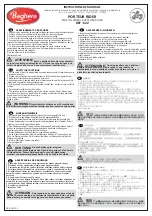
12 • JATO 3.3
RADIO SYSTEM BASIC ADJUSTMENTS
Throttle Neutral Adjustment
The throttle neutral adjustment is located on
the transmitter face and controls the forward/
reverse travel of the throttle trigger. Change
the adjustment by pressing the button and
sliding it to the desired position. There are
two settings available:
50/50
: Allows equal travel for both acceleration and reverse.
70/30
: Allows more throttle travel (70%) and less reverse travel (30%).
50/50 is required setting for the Jato with TRX 3.3 Racing
Engine installed.
Steering Trim
The electronic steering trim located on the face
of the transmitter adjusts the neutral (center)
point of the steering channel.
Multi-Function Knob
The Multi-Function knob can be programmed to
control a variety of functions. From the factory,
the Multi-Function knob controls steering sensitivity, also known as
exponential or “expo.” When the knob is turned counterclockwise
all the way to the left (default position), expo is off and steering
sensitivity will be linear (the most commonly used setting). Turning
the knob clockwise will “add expo” and decrease the steering
sensitivity in the initial range of steering wheel travel left or right from
center. For more detail on steering exponential, refer to page 13.
USING THE RADIO SYSTEM
The TQi Radio System has been pre-adjusted at the factory. The
adjustment should be checked before running the model, in case of
movement during shipping. Here’s how:
1. Turn the transmitter switch on. The status LED on the
transmitter should be solid green (not flashing).
2. Turn on the receiver switch in the model. The switch is located
on the rear shock tower.
3. Position the Jato 3.3 so that its front wheels are off the ground.
4. Turn the steering wheel on the transmitter back and forth and
check for rapid operation of the steering servo. Also, check that
the steering mechanism is not loose or binding. If the steering
operates slowly, check for weak receiver batteries.
5. When looking down at model, the
front wheels should be pointing
straight ahead. If the wheels are
turned slightly to the left or right,
slowly adjust the steering trim
control on the transmitter until
they are pointing straight ahead.
6. Operate the throttle trigger on the transmitter and check for
rapid operation of the throttle servo. When the throttle trigger
is pulled back, the carburetor should open. When the throttle
trigger is pushed all the way forward, the brake should lock.
7. Once adjustments are made, turn off the receiver on your
model, followed by the hand-held transmitter.
Range-Testing the Radio System
Before each running session with your model, you should range-test
your radio system to ensure that it operates properly.
1. Turn on the radio system and check its operation as described in
the previous section.
2. Have a friend hold the model with the engine off.
3. Make sure your transmitter antenna is straight up, and then walk
away from the model with the transmitter until you reach the
farthest distance you plan to operate the model.
4. Operate the controls on the transmitter once again to be sure
that the model responds correctly.
5. Do not attempt to operate the model if there is any problem
with the radio system or any external interference with your
radio signal at your location.
Higher Speeds Require Greater Distance
The faster you drive your model, the more quickly it will near
the limit of radio range. At 60mph, a model can cover 88 feet
every second! It’s a thrill, but use caution to keep your model
in range. If you want to see your model achieve its maximum
speed, it is best to position yourself in the middle of the truck’s
running area, not the far end, so you drive the truck towards and
past your position. In addition to maximizing the radio’s range,
this technique will keep your model closer to you, making it
easier to see and control.
No matter how fast or far you drive your model, always leave
adequate space between you, the model, and others. Never
drive directly toward yourself or others.
When the engine is running,
do not use the throttle trim
on the transmitter to adjust
the engine idle speed.
Always use the idle speed
adjustment screw (see page
15) on the carburetor.
Applying The Decals
The main decals for your model
have been applied at the factory.
The decals are printed on self-
adhesive clear mylar and are
die-cut for easy removal. Use a
hobby knife to lift the corner of a
decal and lift it from the backing.
To apply the decals, place one
end down, hold the other end up,
and gradually smooth the decal
down with your finger as you
go. This will prevent air bubbles.
Placing both ends of the decal
down and then trying to smooth
it out will result in air pockets.
8,9
TRAXXAS TQ
i
RADIO SYSTEM












































